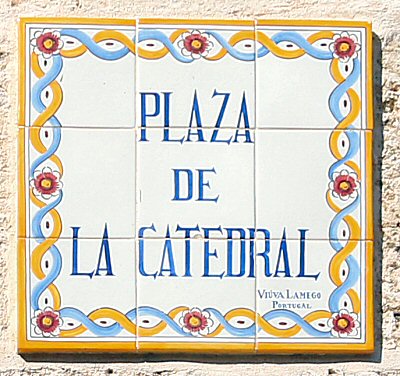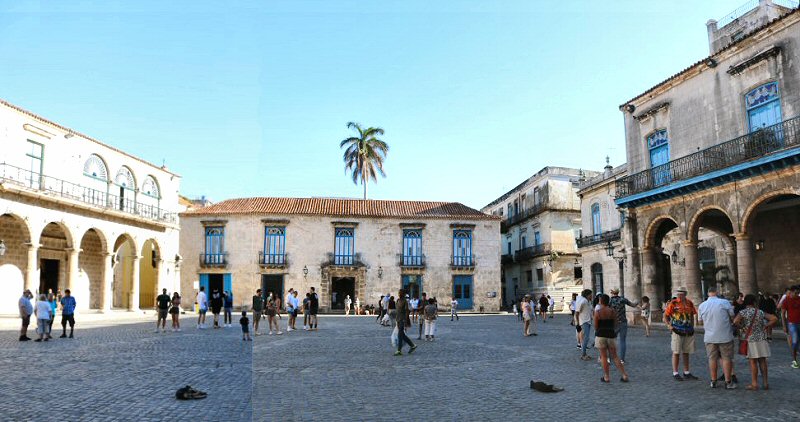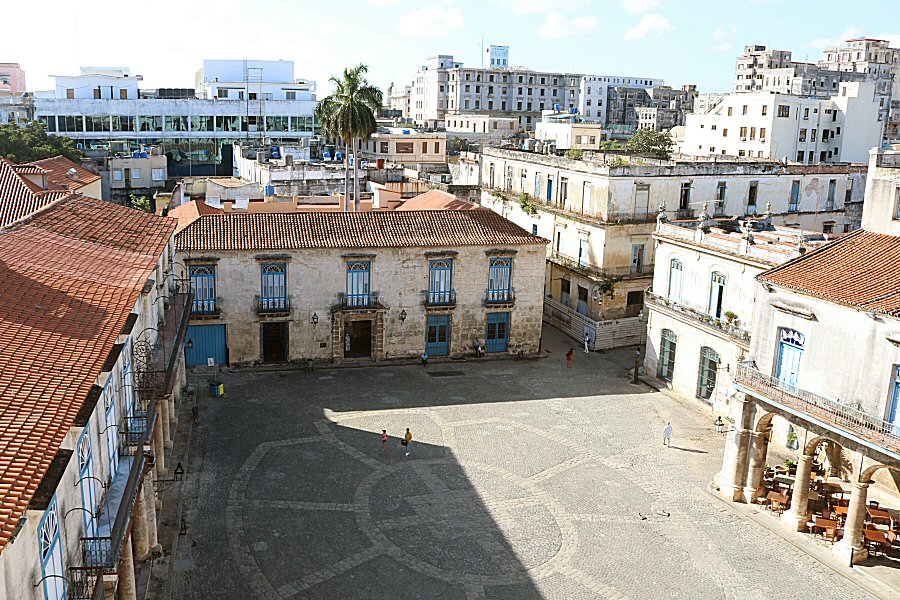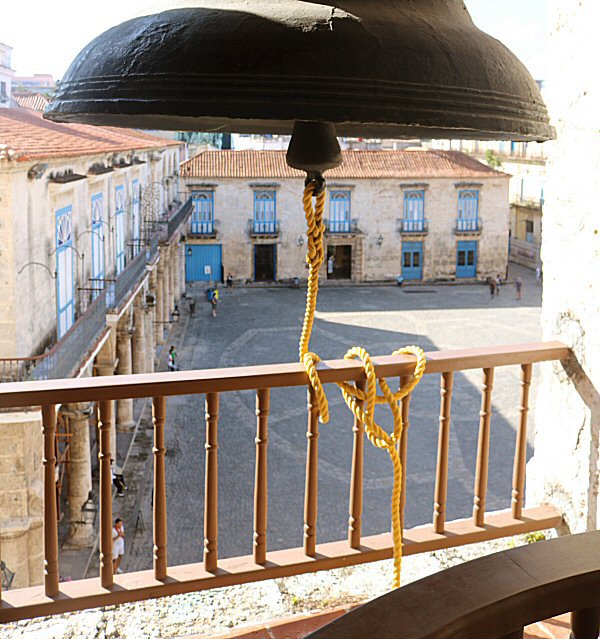
The Plaza de la Catedral is
bordered by the San Ignacio, the O’Reily, the Mercaderes and the
Empedrado streets.
The Plaza de la Catedral
that receives its name from the Catedral de San
Cristóbal de la Habana, is the last of the five plazas,
constructed in Old Havana in the colonial time.
When the town San Cristóbal de la Habana
was founded by the Spanish conquistadors in the 16th
century, the land of the current Plaza de la Catedral was a
watery terrain that was draining the water, flowing along
the town to reach the sea. It was flooded during the tide
also. In 1587, the Governor and the Captain General Gabriel
de Luján ordered to build a large cistern that would be fed
by the springs around, so that the abundant water would be
used to supply the Spanish fleet docking in Havana and for
other purposes. In 1592, the construction of the Zanja Real,
the first water channel of Havana, reached the square and
the cistern built before, so that the water started to
supply the plaza through an open hole at the wall of the
first house of the current Callejón del Chorro. In 1597 this
place was marked with a stone monument.
 During
the 17th century the swampy area was gradually dried up and
used as the naval dockyard, the first in the city, but it
was frozen in the memory of habaneros as a swamp, thus, it
was called as the Plaza de Ciénaga (Swamp Square). The first
record about such a denomination has the date of 1623. The
square was not only used to supply water to boats, but it
became also the place for the artisans that manufactured
products related with the sea and navigation, as well as for
workshops of carpentry and repair of the artillery.
During
the 17th century the swampy area was gradually dried up and
used as the naval dockyard, the first in the city, but it
was frozen in the memory of habaneros as a swamp, thus, it
was called as the Plaza de Ciénaga (Swamp Square). The first
record about such a denomination has the date of 1623. The
square was not only used to supply water to boats, but it
became also the place for the artisans that manufactured
products related with the sea and navigation, as well as for
workshops of carpentry and repair of the artillery.
In the beginning of the 17th century the
area was a less demanding place for the habaneros, but the
situation changed remarkably in the second half of the 17th
century, when the shipyard was moved from there. Its
proximity to other plazas of Old Havana, like the Plaza de
Armas, the Plaza Vieja and the Plaza de San Francisco, led
the habaneros to build their houses around this area. At the
end of the 17th century there was a small humble hermitage,
made by guano and palm leaves and dedicated to San Ignacio
de Loyola, and some primitive wooden houses in the Plaza de
Ciénaga that were replaced by stone buildings later in the
18th century.
In 1700, at the initiative of the
Bishop Diego Evelino
de Compostela, the Jesuits bought the lot where the
humble church was built with the object to build a new
church, convent and school. The construction of the church,
current Catedral de San Cristóbal de la Habana, began in
1748 and could not be completed until 1787, as the Jesuits
were expelled from the island. All the colonial buildings of
wealthy families of the time that are bordering the Plaza de
la Catedral today, like the Casa del Conde de Casa Bayona
(current Museo de Arte Colonial),
Palacio de Lombillo, Casa del Marqués de Arcos and
Casa del Marqués de Aguas Claras (current
restaurant El Patio) were built in this period (1720-1775).
During the construction process of these houses that arouse
admiration among the habaneros, it was inevitable also to
carry out some changes in the square. In 1746, the alley
called Doctor Teneza that was connecting the Mercaderes
street with the plaza, was closed by joining the opposing
houses to build the current Casa del Marqués de
Arcos. The Jagüey street that was a continuous street
from the San Ignacio street to the Compostela street, was
closed by a house that was replaced by another building
later that is occupied by Taller Experimental de la Gráfica
today, forming the current Callejón del Chorro. Upon the
completion of the cathedral the name of the square changed
and hence, it was called Plaza de la Catedral.
The first attempt to rehabilitate the
square, as part of the Project of the Regulatory Plan of Havana, was
done by the French landscape architect Jean Claude Nicolas Forestier that carried many urban works in Cuba from 1925 to
1930 (El Capitolio, Parque de la Fraternidad, Paseo de Martí
etc.). Inspired by the floor of the Plaza del Campidoglio
(Capitol Square) in Rome, designed by Michelangelo,
Forestier designed the pavement of the Plaza de la Catedral
in rosette shape. In 1934 the Ministry of Public Works
decided to restore the old square and entrusted it to the
Cuban architect Luis Bay Sevilla that gave the square the
current appearance. The stone walls were uncovered and the
pavement on the sidewalks were renewed. The restored
buildings around the square were transformed into museums.
The place, between the Palacio de
Lombillo and the adjoining Casa del Marques de Arcos, is
catching most of the tourists’ attention, as there is the
life size bronze statue of the Spanish flamenco dancer and
socialist Antonio Gades (1936-2004). It is represented
leaning against one of the columns of the old building and
looking into the square. From a distance, it looks like, as
if a man in black peeks the tourists for unknown reason, so
that the usual reaction of everybody is to watch the
silhouette for a while, until it will be
clear that the silhouette does not move. It is the work of
the sculptor José Villa Soberón and it was installed in
2007.
At the corner of the
Palacio de Lombillo on the Empedrado street, you can see the
old Cuban lady in a dress typical of a Santera that read
hands and predict the future for a few pesos. She wears many
necklaces and smokes a big cigar.
Live Cuban music, played
by an orchestra in front of the Casa del Marques de Aguas
Claras (El Patio), is almost a constant feature of the
square. During small pauses a member of the orchestra walks
throughout the tables and sells the CDs of their music. The
corner of the Palacio de los Condes de Casa Bayona (Museo de
Arte Colonial) on the San Ignacio street is the place where
another orchestra, consisting of members of older than 60
years, plays Cuban music.



